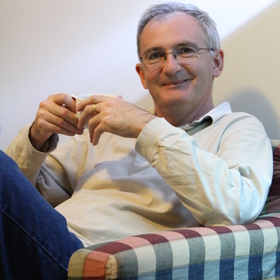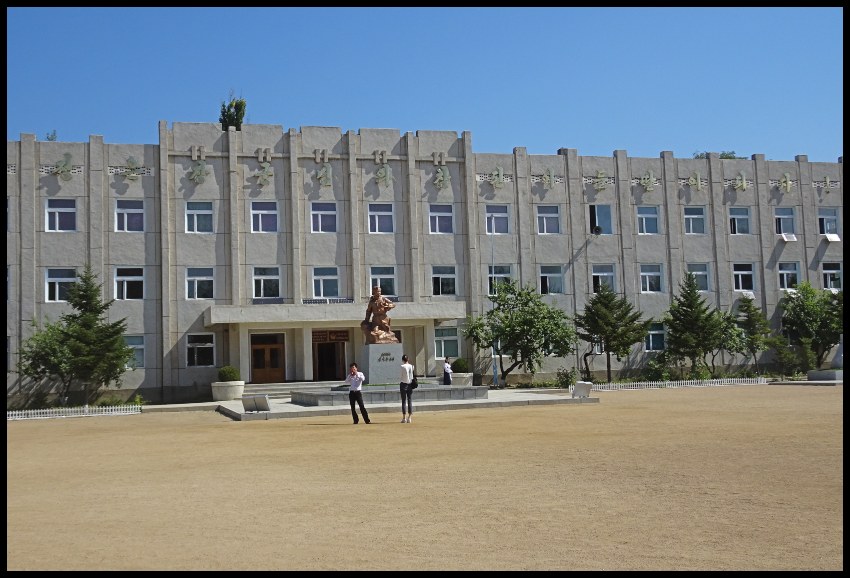On arriving into Hoeryong from Chongjin our first stop was the Kim Ki-song Hoeryong First Middle School, one of the country’s more prestigious secondary schools catering to the offspring of the city’s Nouveau riche. It is named after the revolutionary brother of anti-Japanese war heroine Kim Jong-suk, wife of Kim Il-sung and mother to Kim Jong-il.
With his sister and family, Kim Ki-song left his childhood home in Hoeryong in 1922 in the, as it turned out forlorn, hope of a better life in Manchuria. In 1932 the young boy, now a member of the Children’s Corp, moved (with his sister) into a newly established guerilla zone with the desire and determination to fight to rid Korea of the oppressive Japanese colonist under which his family and his country had been forced to live in abject poverty.

A 2002 North Korean biography on Kim Jong-suk tells us that:
“The people’s wailing over the loss of national sovereignty reverberated everywhere, and the blood of Koreans soaked their own land. The Korean people stood up to fight against the Japanese.”
Kim Ki-song became a bugler within the Children’s Corp, responsible for sounding the reveille each day. After this he would join the remainder of his colleagues for training, often provided by Kim Jong-suk only a couple of years his senior. Such training turned the Corps members into well-qualified guerrillas and skilful political workers admirably setting them up for distinguished service in the great cause of national liberation.
While a member of the Corp’s art troupe, Kim Ki-song’s harmonica solo ‘enveloped the people of the guerrilla zone in an atmosphere of ecstasy’ but it was his bugle playing that would very soon save many of their lives.
In December 1933, due to increased Japanese attacks in the area, a decision was made to evacuate civilians from the Cangcaicun guerrilla zone. Enemy troops spotted the second group, mainly old people and women carrying children on their backs, while being evacuated and began to pursue then up a snow-covered mountain slope. Within a short time bullets were hissing by their ears and the group was within the jaws of death.
At that very moment a bugle sounded from a nearby peak. Kim Ki-song, who was alone, was sounding a charge and the enemy panicked thinking the guerrillas were onto them. Kim Ki-song blew his bugle again and drew the enemy in his direction. The civilian evacuees escaped. Kim Ki-song wasn’t so fortunate and an enemy bullet hit him. At the age of 12 he fell to the ground, never to rise again.
While upset about the death of her brother Kim Jong-suk was not disheartened – “I believe” she said “that though Ki Song died, the hundreds of people snatched from the jaws of death will do the work of Ki Song for the revolution and the country’s liberation. The day will surely come when we will return to the liberated motherland.”
The feats of the young Kim Ki-song are remembered not only in the name but also the ethos of school where the revolutionary spirit of the young boy and of Mt Paektu are still instilled into today’s students albeit, sadly, with a serving of Crystal methamphetamine (ice).
Just over a year prior to my visit the 620 Group, the state organisation tasked with the investigation of illegal drugs, video content and prostitution, was called into the school and found that one in six students (they were publicly named) at the school had consumed crystal methamphetamine and many had engaged in drug induced sex. Drugs are becoming a serious issue throughout North Korea not helped by the fact that illicit drugs are being actively manufactured and exported by the state for foreign currency – a direct response to punitive external sanctions currently imposed on the country.

Needless to say drugs were not discussed on our visit and none were in evidence.
Having heard of the glorious and heroic exploits of Kim Ki-song and admired his statue we moved inside passing though rather dark corridors, decorated with inspirational anti-imperialist posters and quotations, perhaps befitting of an establishment named after a young hero, to reach the English class we would be visiting today.

After watchng the class in action the students were split up and each interested visitor was assigned two students for a short session of ‘one on one’ engagement. (Do you know or can you guess why we each had two students?). In addition to the usual small talk typical in these situations around families, jobs, aspirations and sport my two students, extremely affable 15 year old boys, were beside themselves when telling me about their recent school trip to Pyongyang. They explained how they travelled by plane and how immensely honoured they were to be able to visit all the great sites related to the Kim Dynasty, including the mausoleum of the two former leaders. The trip had inspired them to study more diligently for the ultimate benefit of their country.

But life is not all about classroom study and after our English lesson, in a welcome relief from the usual song and dance performance, we joined students in the playground where we were invited to join into either a game of soccer or volleyball. Quite a few of our group joined in though the tourist teams in both games had to be supplemented by students to get the requisite team sizes. The encounter was fun for student and tourist alike though, not surprisingly, the student teams won.



I watched the soccer and volleyball for a while but was soon attracted to what appeared to be murals on the right hand side of the playground. Expecting to hear a whistle being blown calling me back at any second I ventured forth for a closer look. There was no whistle and what I found was a breakout/rest area with a number of fading scenic murals, a three dimensional map of Korea (incorporating Manchuria) and a rather nice mural depicting Korea as a tiger. I suspect the ensemble had a deeper meaning related to the story of the anti Japanese engagement referred to earlier but I don’t know for sure.



Across the playground there was a large very well kept mural depicting a guerrilla engaged in the liberation of his country. Being unable to read (or speak) Korean I cannot translate the caption accompanying the picture.

Wandering back towards the rest of the group I espied some wooden plaques attached to some trees. On closer inspection I was rather surprised with what was written on them. How very thoughtful of the teachers to provide cue cards like this to assist students in learning the most important English phrases, as they enjoyed their time in the play area!


At least these were fading, perhaps a sign of changing times.
The morning was capped of with group photographs before we continued on our way – to lunch.
My next North Korea (2018) – Hoeryong review– HERE
Start reading at the beginning of my North Korea (2018) – Hoeryong reviews – HERE


Very interesting dear, thanks for sharing.
LikeLiked by 1 person
Thank you for reading
LikeLiked by 1 person
My pleasure.❤️
LikeLike
I admit to severe shock when reading of the sex and drugs as I had read your title as First School and was expecting 5-7 year olds! I’m guessing you had two students so that they could keep an eye (spy) on each other.
LikeLiked by 1 person
Hopefully you picked up it is a secondary school but still bad news. You are spot on re the allocation of two students.
LikeLike
I did pick it up after the momentary shock! Though I’m still surprised that drugs could slip through the net of such a restrictive state into schools. Wouldn’t surprise me to hear the elite had access to everything.
LikeLiked by 1 person
Case of some more equal than others for sure.
LikeLiked by 1 person
All very interesting, naturally! I hadn’t realised that there was such a drugs problem in NK. Your wanders away from the group proved fruitful and fascinating, especially those faded English signs, but can you explain the presence of the giraffe I spotted in one photo?!
LikeLiked by 1 person
Thanks Sarah, Yes a big problem for a while though you will not notice it or hear of it in NK. I don’t think the giraffe has any significance. Concrete moulded animals can be seen in many parks , especially children’s play area. I Perhaps a little odd to see one in a secondary school. I found the zebras at the Mansudae Art Studio a bit more out of place. https://ramblingwombat.wordpress.com/2017/02/17/mansudae-art-studio/
LikeLike
Last year I have seen good Chinese art here in Germany, some kind of anti-propaganda in propagandistic form, some items here reminded me to these special Chinese artworks being no part of the official mainstream at all.
LikeLiked by 1 person
Propaganda art is the mainstream for sure in NK. In mid 2018 they shift the focus of that art from being anti American to being pro NK promotion work, education etc .. more akin to old Soviet propaganda art. Its funny how we call things propaganda .. where do you draw the line especially in the area of government services promotion…
LikeLiked by 1 person
There is a lot of propaganda in this world, the blonde resident of the White House one of the many experts in this regard. After summer holidays I want to write about this phenomena existing for long time.
LikeLiked by 1 person
Indeed. I look forward to see what you write about it 🙂
LikeLiked by 1 person
For good reason, Nazi-symbols are forbidden in Austria and Germany. It would be nice of other countries would follow such a policy as a protective measure for freedom!
LikeLiked by 1 person